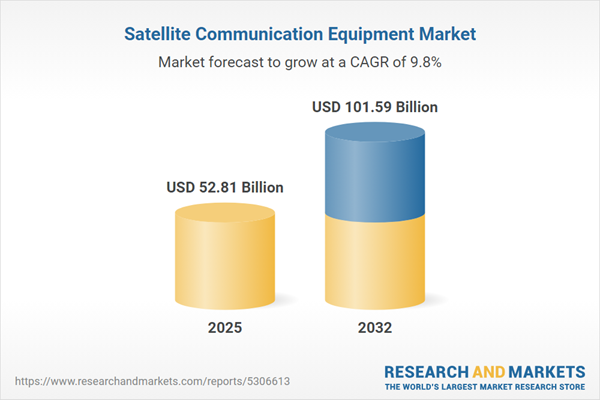Speak directly to the analyst to clarify any post sales queries you may have.
Satellite communication equipment is a strategic asset for organizations needing secure, reliable connectivity in demanding, infrastructure-challenged, or regulated environments. For enterprises operating in remote areas or with mobile assets, these systems are essential for sustaining critical operations, enabling business continuity, and supporting agile growth strategies.
Market Snapshot: Satellite Communication Equipment Market Overview
The satellite communication equipment market demonstrates strong, sustained expansion, with a compound annual growth rate (CAGR) of 9.81%. Current market value stands at USD 48.04 billion in 2024, projected to reach USD 52.81 billion by 2025 and USD 101.59 billion by 2032. This trajectory reflects accelerating advancements in network architecture, capital investment, and the proliferation of multi-orbit constellations. Enhanced performance, continuous improvements in security protocols, and regulatory compliance requirements are driving greater adoption across commercial, defense, and government sectors. Organizations leveraging these systems can ensure reliable communications even where terrestrial alternatives cannot deliver consistent service.
Scope & Segmentation in the Satellite Communication Equipment Market
- Equipment Types: Ground-based antennas, satellite modems, hub stations, portable user terminals, satellite phones, and VSAT terminals deliver dependable communication in areas lacking conventional infrastructure. Each type supports distinct operational demands, ranging from critical data exchange to immediate voice connectivity.
- Platforms: Aeronautical, land mobile, fixed VSAT, and mobile VSAT platforms handle connectivity needs for transportation, logistics, and industrial operations. These platforms are vital for operations requiring flexibility and mobility across sectors.
- Frequency Bands: C, Ka, Ku, and L bands enable tailored coverage and resilience, addressing operational, regulatory, and security considerations for diverse applications.
- Applications: Enterprise, defense, broadcasting, maritime, aviation, oil and gas, infrastructure, and government organizations use satellite communication to maintain voice and data transmission, especially when terrestrial networks are unreliable or inaccessible.
- Service Types: Provisioning, technical support, network management, and remote monitoring uphold system integrity and ensure continuous operation across distributed assets and critical supply chains.
- Regions: Americas, Europe, Middle East, Africa, and Asia-Pacific each reflect unique regulatory frameworks, infrastructure maturity, and investment trends, shaping adoption approaches and solution preferences.
- Key Companies: Hughes Network Systems, Viasat, SES, Intelsat, Eutelsat, Inmarsat, Telesat, Gilat Satellite Networks, Cobham, and L3Harris Technologies provide core technology that enables secure and scalable global communications.
Key Takeaways for Senior Decision-Makers
- Adoption of flexible antenna systems and software-defined payloads allows rapid response to changing operational and regulatory requirements.
- Hybrid integration with terrestrial networks increases network resilience, supporting operations amid unpredictable conditions and reducing downtime risks.
- Ongoing review of regulatory changes and proactive identification of supply chain challenges reinforce compliance and organizational stability.
- Centralized monitoring and robust network management elevate oversight, giving distributed teams enhanced control and optimizing resource allocation.
- Partnering with established solution providers streamlines deployment and ensures alignment with evolving organizational goals.
- Investing in modular, scalable communication solutions prepares enterprises for seamless integration with IoT and new-generation technologies.
Tariff Impact: United States 2025 Measures
New U.S. tariff measures for 2025 are influencing satellite communication equipment manufacturers to reconsider procurement strategies and production locations. A focus on domestic manufacturing and diversified sourcing is emerging, helping organizations adapt to regulatory change while minimizing potential service disruptions. This approach strengthens supply chain resilience and assists in maintaining service reliability within a shifting regulatory environment.
Methodology & Data Sources
This market assessment combines executive interviews, technical and regulatory analysis, and patent trend tracking. Systematic benchmarking across all segments enables accurate insights, supporting procurement, compliance, and technology investment decisions in business-critical contexts.
The Satellite Communication Equipment Market: Why This Report Matters
- Equips senior leaders with intelligence to enhance risk management and ensure continuity as sourcing strategies and regulations evolve.
- Supplies actionable perspectives for refining technology, operations, and procurement planning amid dynamic market and policy shifts.
- Fosters informed investment and collaboration across sectors to maintain operational robustness and future competitiveness.
Conclusion
Proactive market insight and strategic planning equip organizations to sustain uninterrupted connectivity and adapt rapidly to industry evolution. Careful preparation is essential for long-term resilience in the satellite communication equipment sector.
Additional Product Information:
- Purchase of this report includes 1 year online access with quarterly updates.
- This report can be updated on request. Please contact our Customer Experience team using the Ask a Question widget on our website.
Table of Contents
3. Executive Summary
4. Market Overview
7. Cumulative Impact of Artificial Intelligence 2025
Companies Mentioned
The companies profiled in this Satellite Communication Equipment market report include:- Hughes Network Systems, LLC
- Viasat, Inc.
- SES S.A.
- Intelsat, Ltd.
- Eutelsat S.A.
- Inmarsat Global Limited
- Telesat Canada
- Gilat Satellite Networks Ltd.
- Cobham Limited
- L3Harris Technologies, Inc.
Table Information
| Report Attribute | Details |
|---|---|
| No. of Pages | 199 |
| Published | October 2025 |
| Forecast Period | 2025 - 2032 |
| Estimated Market Value ( USD | $ 52.81 Billion |
| Forecasted Market Value ( USD | $ 101.59 Billion |
| Compound Annual Growth Rate | 9.8% |
| Regions Covered | Global |
| No. of Companies Mentioned | 11 |









